The
Sugar Bush
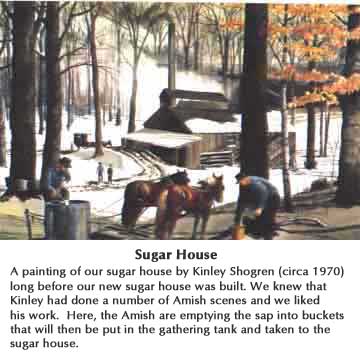 We
purchased our farm in 1959. Along with the farm came a dilapidated sugar
house that had not been used for several years. However since our farm
included about sixty acres of woods with many mature trees and a potentially
functional sugar house, we decided to reactivate the maple syrup operation.
It was necessary to purchase some new equipment which was not difficult
to find. We
purchased our farm in 1959. Along with the farm came a dilapidated sugar
house that had not been used for several years. However since our farm
included about sixty acres of woods with many mature trees and a potentially
functional sugar house, we decided to reactivate the maple syrup operation.
It was necessary to purchase some new equipment which was not difficult
to find.
The
Amish
Our next job was to find some Amishmen to gather the sap and boil it down
to make maple syrup. This was more difficult to do. However, after considerable
searching, we found two Amish gentlemen, who with the help of their families,
agreed to attempt this operation.
Unfortunately,
these men had had very little experience in this type of operation which
required more skill than either they or we thought. As a result, a large
amount of syrup was made that was below standard and could not be sold.
This was because the syrup was not boiled long enough to
reach
the proper density.
Modern
Instruments
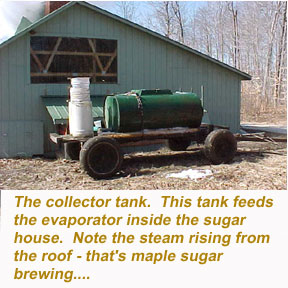 We
purchased modern instruments to test the syrup to make certain that it
was the correct density. However, the
Amish saw no need to use these "newfangled " gadgets so they
tried to judge the density of the syrup in a very primitive manner the
way their fathers did. With much persuasion, they reluctantly agreed to
use the instrument that I had provided them. The density is measured by
a hydrometer or a refractometer. Both of these instruments are very easy
to use. We
purchased modern instruments to test the syrup to make certain that it
was the correct density. However, the
Amish saw no need to use these "newfangled " gadgets so they
tried to judge the density of the syrup in a very primitive manner the
way their fathers did. With much persuasion, they reluctantly agreed to
use the instrument that I had provided them. The density is measured by
a hydrometer or a refractometer. Both of these instruments are very easy
to use.
Financial
ArrangementsIt is interesting that when we first started up the sugar
house in 1950, a gallon of syrup sold for $6.50 a gallon and now sells
for $35.00.The usual financial arrangement at that time was for the owner
to supply all of equipment and the land with the maple trees so the men
doing the work had no cash outlay. The final product (the maple syrup)
was split 50:50. Now the split is 2/3 for the operators leaving 1/3 for
the owner.
Making
Syrup
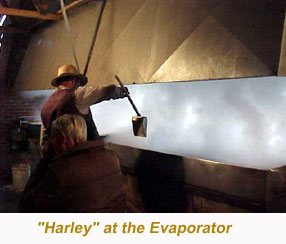 The
season for syrup making is usually in March, often extending into April.
It starts after at thaw of several days and continues until the trees
start to bud out. A difficult decision in making maple syrup is choosing
the proper time to tap the trees. It can be a real gamble. If we tap too
early, we risk having no thaw for a time, and a thaw is necessary for
the sap to run. If we tap too late and spring comes early, the season
is too short to make much syrup. In order for syrup to achieve a delicate
taste, equipment must be clean, the sap gathered before it stands too
long in the buckets and then it should be boiled off rapidly. There is
nothing magic about the first run except that the buckets and evaporator
have just been cleaned, the weather is usually cool and the operators
are eager to get started and gather the sap promptly. Excellent syrup
can be made at any time. Our current operator, Harley, has made superior
syrup all through the season. The
season for syrup making is usually in March, often extending into April.
It starts after at thaw of several days and continues until the trees
start to bud out. A difficult decision in making maple syrup is choosing
the proper time to tap the trees. It can be a real gamble. If we tap too
early, we risk having no thaw for a time, and a thaw is necessary for
the sap to run. If we tap too late and spring comes early, the season
is too short to make much syrup. In order for syrup to achieve a delicate
taste, equipment must be clean, the sap gathered before it stands too
long in the buckets and then it should be boiled off rapidly. There is
nothing magic about the first run except that the buckets and evaporator
have just been cleaned, the weather is usually cool and the operators
are eager to get started and gather the sap promptly. Excellent syrup
can be made at any time. Our current operator, Harley, has made superior
syrup all through the season.
Our
evaporator uses wood as it's heat source. Both the cutting of the wood
and the gathering of the sap in the snow and the mud are backbreaking
work. It takes on the average forty-five gallons of sap to make a gallon
of maple syrup.
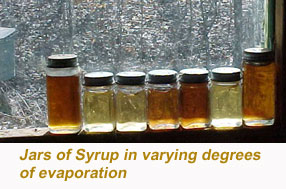 The
New Sugar House The
New Sugar House
The century old sugar house continued to deteriorate so that it looked
like it might fall down at any moment. There was no choice but to build
a new one. The new sugar house contains an evaporator 16 foot long and
five foot wide. The evaporator boils the water out of the maple sap to
make the maple sugar.
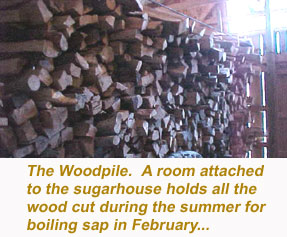 The sugar
house also holds many cords of wood as many cords of wood are used each
season. The Amish use horses to pull a wagon through the woods to gather
the sap and then deliver the sap to the sugar house. Also there is a horse
stall in the front of the sugar house to keep the horses out of the weather
when they are resting between trips through the woods. The sugar
house also holds many cords of wood as many cords of wood are used each
season. The Amish use horses to pull a wagon through the woods to gather
the sap and then deliver the sap to the sugar house. Also there is a horse
stall in the front of the sugar house to keep the horses out of the weather
when they are resting between trips through the woods.
We
are very proud of the new sugar house. It has large plate glass windows
and is a showplace among sugar houses. It was built by an Amish crew.
The head of the crew has sixteen children. as does the current operator.
I asked the builder of the sugar house how he could support sixteen children.
He thought a moment and then said, "I just work hard". Both
the builder and the operator are fine intelligent gentlemen. I enjoy very
much being with them.
|